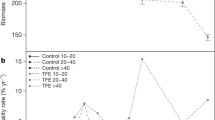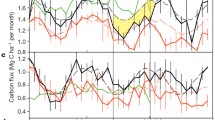Abstract
Drought-induced vegetation mortality has been documented on every vegetated continent in recent decades and constitutes a major uncertainty in climate change impacts on terrestrial ecosystems and carbon cycle feedbacks. While recent research has focused on specific failure mechanisms during drought-induced forest die-off, a broader understanding of the physiology of trees under drought, especially changes in growth and carbon allocation, is needed for determining the sensitivity of forests to drought and interacting mechanisms during forest mortality. I present here multi-tissue and high-resolution temporal dynamics of tree carbon resources during moderate experimental and natural drought in trembling aspen (Populus tremuloides) forests, a major forest type in western North America that recently experienced widespread drought-induced die-off. Drought led to substantial declines in inferred carbon uptake. Tree carbohydrate concentrations, however, largely increased in concert with substantial decreases in growth and severe declines in root biomass. These findings highlight that growth declines, especially in fine roots which are important to water uptake, and increased carbon allocation to root non-structural carbohydrates are key responses to drought in aspen and could play an important role in widespread die-off. They suggest multi-year consequences of drought and carbon-hydraulic interconnections. They underscore the need for a more integrated multi-tissue, multi-process, and multi-year perspective of climate-induced forest mortality.



Similar content being viewed by others
References
Adams HD et al (2009) Temperature sensitivity of drought-induced tree mortality portends increased regional die-off under global-change-type drought. Proc Natl Acad Sci USA 106:7063–7066
Allen CD et al (2010) A global overview of drought and heat-induced tree mortality reveals emerging climate change risks for forests. Forest Ecol Manag 259:660–684
Anderegg WRL, et al (In Review) Drought characteristics explain patterns in widespread aspen forest mortality across the western United States. Oecologia
Anderegg WRL et al (2011) The roles of hydraulic and carbon stress in a widespread drought-induced forest mortality. Proc Natl Acad Sci USA. doi:10.1073/pnas.1107891109
Barr AG et al (2007) Climatic controls on the carbon and water balances of a boreal aspen forest, 1994–2003. Glob Chang Biol 13:561–576
Bonan GB (2008) Forests and climate change: forcings, feedbacks, and the climate benefits of forests. Science 320:1444–1448
Breshears DD et al (2005) Regional vegetation die-off in response to global-change-type drought. Proc Natl Acad Sci USA 102:15144–15148
Dale VH, Joyce LA, McNulty S, Neilson RP (2000) The interplay between climate change, forests, and disturbances. Sci Total Environ 262:201–204
Galvez DA, Landhäusser SM, Tyree MT. (2011) Root carbon reserve dynamics in aspen seedlings: does simulated drought induce reserve limitation? Tree Physiol 31:250–257.
Gower ST, Vogel JG, Norman JM, Kucharik CJ, Steele SJ, Stow TK (1997) Carbon distribution and aboveground net primary production in aspen, jack pine, and black spruce stands in Saskatchewan and Manitoba, Canada. J Geophys Res 102(29):029–041
Hartmann H (2011) Will a 385 million year-struggle for light become a struggle for water and for carbon? – how trees may cope with more frequent climate change-type drought events. Glob Chang Biol 17:642–655
Hogg EH, Brandt JP, Kochtubajda B (2005) Factors affecting interannual variation in growth of western Canadian aspen forests during 1951–2000. Can J For Res 35:610–622
Hsiao TC (1973) Plant responses to water stress. Annu Rev Plant Physiol 24:519–570
Huang C, Anderegg WRL (2012) Large regional drought-induced biomass losses of the rocky mountain aspen forests. Glob Change Biol 18:1016–1027. doi:10.1111/j.1365-2486.2011.02592.x
Jackson RB, Mooney HA, Schulze ED (1997) A global budget for fine root biomass, surface area, and nutrient contents. Proc Natl Acad Sci USA 94:7362–7366
Kurz W et al (2008a) Mountain pine beetle and forest carbon feedback to climate change. Nature 452:987–990
Kurz W, Stinson G, Rampley GJ, Dymond CC, Neilson ET (2008b) Risk of natural disturbances makes future contribution of Canada’s forests to the global carbon cycle highly uncertain. Proc Natl Acad Sci USA 105:1551–1556
Maurer EP, Wood AW, Adam JC, Lettenmaier DP, Nijssen B (2002) A long-term hydrologically based dataset of land surface fluxes and states for the conterminous United States. J Clim 15:3237–3251
McDowell N et al (2008) Mechanisms of plant survival and mortality during drought: why do some plants survive while others succumb to drought? New Phytol 178:719–739
McDowell N, Beerling DJ, Breashers DD, Fisher RA, Raffa K, Stitt M (2011) Interrelated mechanisms of drought-induced tree mortality. Trends Ecol Evol 26:523–531
Perala DA (1990) Populus tremuloides. In: Burns RM, Honkala BH (eds) Silvics of North America. Hardwoods. United States Department of Agriculture Forest Service, Washington, DC, pp 555–569
Phillips OL et al (2009) Drought sensitivity of the Amazon rainforest. Science 323:1344–1348
Pinno BD, Wilson SD, Steinaker DF, Van Rees KCJ, McDonald SA (2010) Fine root dynamics of trembling aspen in boreal forest and aspen parkland in central Canada. Ann For Sci 67:710–716
Rehfeldt GE, Ferguson DE, Crookston NL (2009) Aspen, climate, and sudden decline in western USA. Forest Ecol Manag 258:2353–2364
Sala A (2009) Lack of direct evidence for the carbon-starvation hypothesis to explain drought-induced mortality in trees. Proc Natl Acad Sci USA 106:E68
Sala A, Piper F, Hoch G (2010) Physiological mechanisms of drought induced tree mortality are far from being resolved. New Phytol 186:274–281
Schulze ED, Robichaux RH, Grace J, Rundel PW, Ehleringer JR (1987) Plant water balance. BioScience 37:30–37
Sperry JS, Perry A, Sullivan JEM (1991) Pit membrane degradation and air-embolism formation in aging xylem vessels of Populus tremuloides. J Exp Bot 42:1399–1406
Van Mantgem PJ et al (2009) Widespread increase of tree mortality rates in the western United States. Science 323:521–525
Worrall JJ et al (2010) Effects and etiology of sudden aspen decline in southwestern Colorado. Forest Ecol Manag 250:638–652
Acknowledgements
I thank E. Callaway, L. Anderegg, M. Anderegg, M. Love, C. Sherman for assistance with fieldwork. I thank E. Pringle, T. Raab, L. Anderegg, A. Winslow, A. Hauslade, N. Bitler, A. Lunny, W. Lagrandeur, J. Burr, A. Hines, M. Erviti, G. Griffin, M. Dini, S. Shin for assistance in laboratory work. I thank H. Mooney, J. Berry, and C. Field for helpful comments on the manuscript and A. Nees for providing the landscape fine root data. I thank the Bill Lane Center for the American West, Morrison Institute of Population and Resource Studies, Phi Beta Kappa Northern California Association, Jasper Ridge Biological Preserve, Stanford Biology SCORE Program for research equipment and funding. W.R.L.A. was supported in part by an award from the Department of Energy (DOE) Office of Science Graduate Fellowship Program (DOE SCGF). The DOE SCGF Program was made possible in part by the American Recovery and Reinvestment Act of 2009. The DOE SCGF program is administered by the Oak Ridge Institute for Science and Education for the DOE. ORISE is managed by Oak Ridge Associated Universities (ORAU) under DOE contract number DE-AC05-06OR23100. All opinions expressed in this paper are the author’s and do not necessarily reflect the policies and views of DOE, ORAU, or ORISE.
Author information
Authors and Affiliations
Corresponding author
Electronic supplementary material
Below is the link to the electronic supplementary material.
ESM 1
(DOC 40 kb)
Figure S1
Sap-flow (mean +/− SEM; kg H2O/m2 sapwood area/day) of a the healthier, northwest-facing stand (Site H; gray) and more stressed, south-facing stand (Site S; black) during seasonal drought. (PDF 38 kb)
Figure S2
Percent dry mass (mean +/− SEM) of starch (A) and sucrose (B) in tissues from potted trees on a bi-weekly basis. Blue bars are those of control trees; Red bars are those of drought trees. (PDF 52 kb)
Rights and permissions
About this article
Cite this article
Anderegg, W.R.L. Complex aspen forest carbon and root dynamics during drought. Climatic Change 111, 983–991 (2012). https://doi.org/10.1007/s10584-012-0421-9
Received:
Accepted:
Published:
Issue Date:
DOI: https://doi.org/10.1007/s10584-012-0421-9




